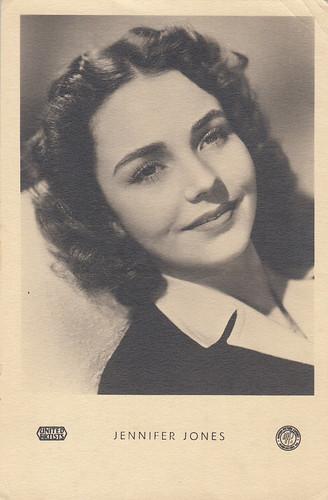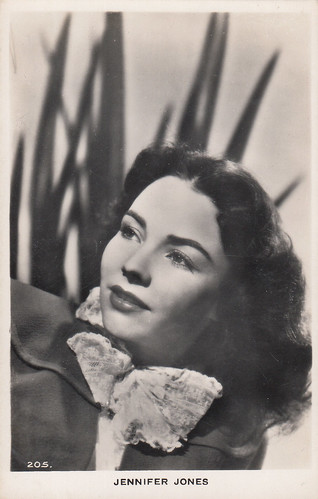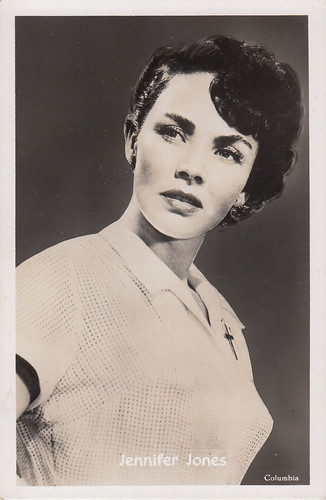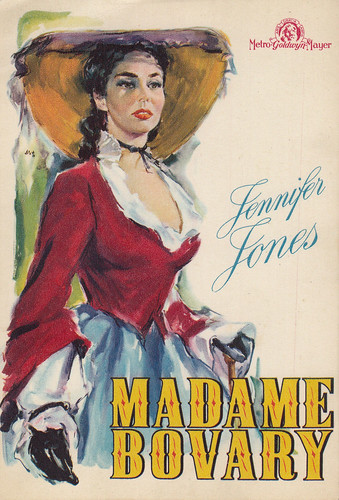Her name will forever be linked to that of David O’Selznick. He made her a star and always kept a watchful eye on her career, although the choices he made for her didn’t always pay off. To be fair, several top-quality films such as Portrait of Jennie or Carrie didn’t deserve to be commercial failures. Onscreen, Jennifer Jones was a versatile actress and brought a special intensity to most of her roles. In private, she was known to be a rather shy and insecure person, who was never really at ease with stardom. She is one of my favourite actresses. So, I’m happy to pay homage to her through this post.

British postcard by Picturegoer, no. W127. Jennifer Jones in The Song of Bernadette (Henry King, 1943). Photo: Twentieth Century Fox.

American postcard. Photo: W.J. Gray, L.A.

American postcard by the Selznick Studio, Culver City, California. Sent by mail in 1944.

Vintage postcard. Photo: United Artists. Jennifer Jones in Since You Went Away (John Cromwell, 1944).

Italian postcard by Ballerini & Fratini, Firenze, no. 2495. Photo: Paramount Films. Jennifer Jones in Love Letters (William Dieterle, 1945).
Bitten by the acting bug.
Jennifer Jones was born Phylis Isley on the 2nd of March 1919 in Tulsa, Oklahoma, U.S.A. At the time, her parents, Phil Isley and Flora Mae Suber had their own travelling tent-show theatrical company, the 'Isley Stock Company'. At the end of the 1920s and the beginning of the 1930s, Phil Isley wisely purchased a number of movie theatres and became one of the prominent exhibitors in the Oklahoma-Texas area.
From an early age, Phylis dreamed of becoming an actress. In the autumn of 1936, she enrolled at Northwestern University, a college renowned for its drama department. Dissatisfied with the courses she was given, she decided she didn’t want to spend a second year there and quit.
After gaining acting experience, through her father’s connexions, in the 'Mansfield Players Stock Company', during their 1937 summer tour, Phylis entered the prestigious New York American Academy of Dramatic Arts in September.
That’s where she met an aspiring young actor named Robert Walker. They fell in love and left the Academy after one academic year. Thanks to her father, Phylis got her own weekly radio show in Tulsa, the 'Phylis Isley Radio Theater', at the end of 1938.
Phylis and Robert Walker were married on the 2nd of January 1939 and Phil Isley advised them to try their luck in Hollywood. Paramount was not impressed but Phylis was signed by Republic Studios, where she played opposite John Wayne in New Frontier (George Sherman, 1939) and was Gwen, Dick Tracy’s secretary, in the serial Dick Tracy’s G-Men (John English, William Witney, 1939). After those two films, she asked to be released from her contract. Back in New York, she gave birth to two sons, Robert Jr in April 1940 and Michael in March 1941.

Dutch postcard by Uitgave P.F. Cladder, Amsterdam, no. 49-3.

German postcard by Kitt photokarten, München, no. 606. Photo: United Artists.

Italian postcard by Ballerini & Fratini, Firenze, no. 2084. Photo: Paramount Films.

Spanish postcard by C.M.B., no. 59. Photo: 20th Century Fox. Jennifer Jones in Cluny Brown (Ernst Lubitsch, 1946).

British postcard no. 205.
Groomed by David O’Selznick
When she learnt that a Chicago production of the Broadway hit 'Claudia' was going to be staged, Phylis decided to test for the title role but, in the end, it was Phyllis Thaxter who was chosen.
Kay Brown, David O’Selznick’s renowned and efficient New York representative, brought the young girl to the famous producer’s attention and arranged for an audition and a screen test.
An impressed Selznick, who owned the film rights to 'Claudia', decided to sign her in July 1941. A disappointed Phylis soon learned that she was never to play in Claudia (Edmund Goulding, 1943), which was finally filmed with Dorothy McGuire.
However, Selznick had started to take a deep personal interest in his latest discovery, whom he had decided to groom for stardom, and, in January 1942, her name was changed to Jennifer Jones.
He wanted his protegee to be given the much-coveted role of Saint Bernadette Soubirous in the forthcoming production The Song of Bernadette and began negotiating with 20th Century Fox executives to convince them that she would be an ideal choice. After a successful screen test, she got the part. The Song of Bernadette (Henry King, 1943) made Jennifer Jones a star and earned her a Best Actress Oscar. She suddenly became hot property in Hollywood.
Since you Went Away (John Cromwell, 1944), a sentimental drama about the effects of World War II on an upper-middle-class American family, Love Letters (William Dieterle, 1945), in which she played an amnesiac, and the comedy Cluny Brown (Ernst Lubitsch, 1946) successfully followed.
In 1946, Jennifer played sultry half-breed Pearl Chavez in the flamboyant Western Duel in the Sun (King Vidor, 1946). On the whole, it wasn’t favourably received by film critics. Furthermore, the Catholic Church found it morally objectionable. Nevertheless, people flocked to see it and it was a top box-office hit.

Italian postcard by Ballerini & Fratini, Firenze, no. 2248. Photo: United Artists. Jennifer Jones in Duel in the Sun (King Vidor, 1946).

Egyptian postcard. Jennifer Jones in Duel in the Sun (King Vidor, 1946).

Spanish postcard by Soberanas, Barcelona, no. 341. Jennifer Jones in Duel in the Sun (King Vidor, 1946).

Spanish postcard. Jennifer Jones in Duel in the Sun (King Vidor, 1946).

Dutch postcard by Takken, no. A.X. 451. Photo: United Artists.
A career of up and downs
Jennifer Jones then appeared in Portrait of Jennie (William Dieterle, 1949). It has since become a classic but was a flop at the time, as was They Were Strangers (John Huston, 1949). She also starred in Vincente Minnelli’s lavish M.G.M. production Madame Bovary (Vincente Minnelli, 1949). That same year, Jennifer Jones and David O’Selznick, after their respective divorces, married.
In England, Jennifer was directed by Michael Powell and Emeric Pressburger in Gone to Earth (1950). At its release in the U.K. in 1950, it failed to attract audiences. It met the same fate in 1952 when it was shown in the U.S., in a revised version, as The Wild Heart.
The public also didn’t respond warmly to Carrie (William Wyler, 1952), which was found too grim. Fortunately, Jennifer had a hit with Ruby Gentry (King Vidor, 1952), a steamy melodrama which was launched with the tagline "A Siren Who Wrecked a Whole Town - Man by Man - Sin by Sin".
In 1953, she went to Rome to co-star with Montgomery Clift in Vittorio de Sica’s Stazione Termini (1953). In Italy, it didn’t meet the expected success. When, one year later, it was shown in the U.S. in a heavily cut version, as Indiscretion of an American Wife, it flopped. Audiences also stayed away from the offbeat Beat the Devil (John Huston, 1954).
Jennifer Jones came back to the top thanks to Love is a Many-Splendored Thing (Henry King, 1955), Good Morning Miss Dove (Henry Koster, 1955) and The Man in the Gray Flannel Suit (Nunnally Johnson, 1956).
After The Barretts of Wimpole Street (Sidney Franklin, 1957), she co-starred with Rock Hudson in A Farewell to Arms (Charles Vidor, 1957), which was severely panned by most reviewers. It made some financial profit for 20th Century Fox but its harsh critical reception hit Jennifer and her husband hard. Selznick never produced another movie.

Italian postcard by Bromofoto, Milano, no. 148.

Italian postcard by Bromofoto, Milano, in the 'Costumi sardi' series. Collection: Marlene Pilaete. In this series, Bromofoto had the weird idea to put famous stars’ faces on the bodies of Sardinian people dressed in traditional costumes. They didn’t bother to mention the names of the stars on the back of the postcards. You will notice that Bromofoto used the same Jennifer Jones photo on their postcard no. 148.

Belgian postcard by Nieuwe Merksemsche Chocolaterie S.P.R.L., Merksem Anvers, no. D7. Photo: Columbia. Jennifer Jones in We Were Strangers (John Huston, 1949).

West-German postcard by Kunst und Bild Berlin, no. S 711. Photo: MGM. Jennifer Jones in Madame Bovary (Vincente Minnelli, 1949).

Italian promotional postcard for Madame Bovary (Vincente Minnelli, 1949) by Zincografica, Firenze.
The sixties: the difficult years
After a three-year absence from the screen, Jennifer Jones reappeared in Tender Is the Night (Henry King, 1961). It didn’t win the popular appeal and several critics found that she was too old for the part of Nicole.
At the beginning of the 1960s, Jennifer’s services were not in demand anymore and her career came to a standstill. David O’Selznick’s death in 1965 left her disoriented. She had lost the man who had been the driving force behind her professional life.
She then chose to accept a film offer from England but The Idol (Daniel Petrie, 1966) failed to generate interest and was not the kind of movie to inspire other producers to seek her out.
In 1967, she was found unconscious on a California beach, after an overdose of sleeping pills. She later declared that it was more a cry for help rather than a real desire to end her life.
Rather inexplicably, she accepted to play a former porno star in Angel, Angel, Down We Go (Robert Thom, 1969), which turned up to be so poor that it quickly vanished from the theatres. It was re-released in 1970 as Cult of the damned but it did no better.
Wanting to give a new direction to her life, she became involved, at the end of the 1960s, in the Los Angeles-based 'Manhattan Project', a program for emotionally disturbed youngsters and drug addicts, for which she proved to be a highly effective fund-raiser.

French postcard by Editions P.I., Paris, no. 210 D. Photo: Paramount. Collection: Marlene Pilaete.

German postcard by Film-Foto-Verlag, Berlin-Tempelhof, no. FK 304. Photo: Paramount Pictures.

Italian postcard by Vetta Traldi, Milano, no. 10. Jennifer Jones in Stazione Termini/Indiscretion of an American Wife (Vittorio De Sica, 1953).

Vintage postcard. Photo: London Films.

Italian postcard by Ballerini & Fratini, Firenze, no. 2438. Photo: Minerva Film. Jennifer Jones in Gone to Earth (Michael Powell, Emeric Pressburger, 1950).
A new chapter in her life
In 1971, she married multi-millionaire and art collector Norton Simon. Her husband encouraged her to make her screen comeback by joining the star-studded cast of one of the 1970s top-grossing blockbusters, The Towering Inferno (John Guillermin, 1974).
In May 1976, Mary Jennifer, the daughter she had from Selznick in 1954, committed suicide. A few weeks later, Jennifer’s father passed away. She overcame her grief by committing herself stronger to the cause of mental issues. As a result, the 'Jennifer Jones Simon Foundation for Mental Health and Education' was founded in 1980.
Her movie career was never reactivated, although she had been interested at one time to portray the murderess Jean Harris onscreen, the project didn’t come off. Jennifer and her husband also optioned the film rights to the novel 'Terms of Endearment' but, when she learnt that she was considered too old by director James Brooks to play the mother role, she gave up the idea. The part went to Shirley MacLaine, who got an Oscar for it.
In 1989, she was named Chairwoman of the famous Norton Simon Art Museum and stayed so until 2003, when she was given emeritus status. In the 1990s, her interest in the world of psychiatry still vivid, she worked as a paraprofessional therapist and volunteered as a counsellor at the Southern California Counseling Center in Beverly Hills.
Widowed in 1993, Jennifer Jones spent the last six years of her life with her son Robert Jr and his family and passed away on the 17th of December 2009.

Italian postcard by Bromostampa, Milano, no. 342.

Argentinian postcard by Cromocart G.W., no. 147. Photo: Columbia. Jennifer Jones in Love is a Many-Splendored Thing (Henry King, 1955).

Vintage postcard. Photo: 20th Century Fox.

West-German postcard by WS Druck, Wanne-Eickel, no. F 112.
Text and postcards: Marlene Pilaete.
No comments:
Post a Comment